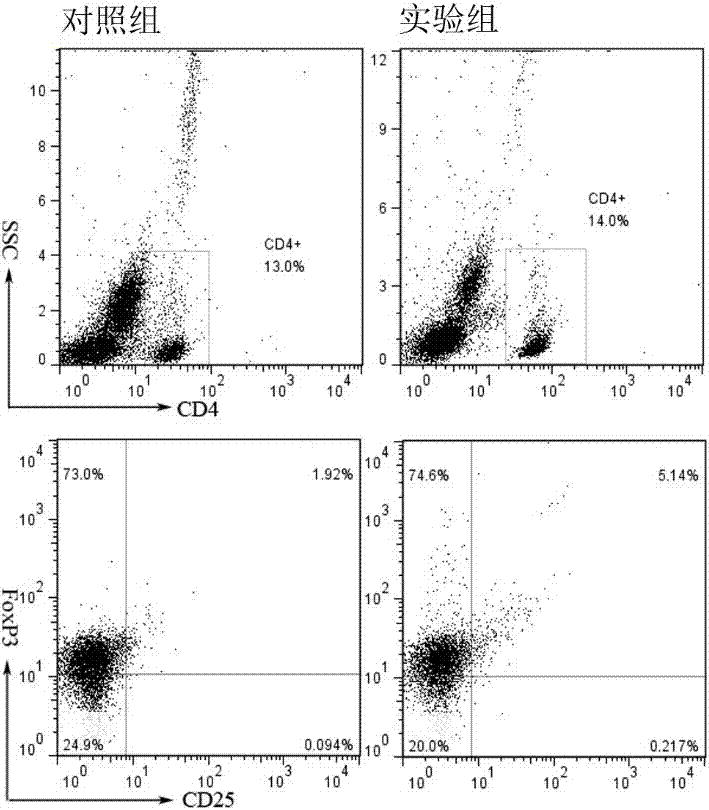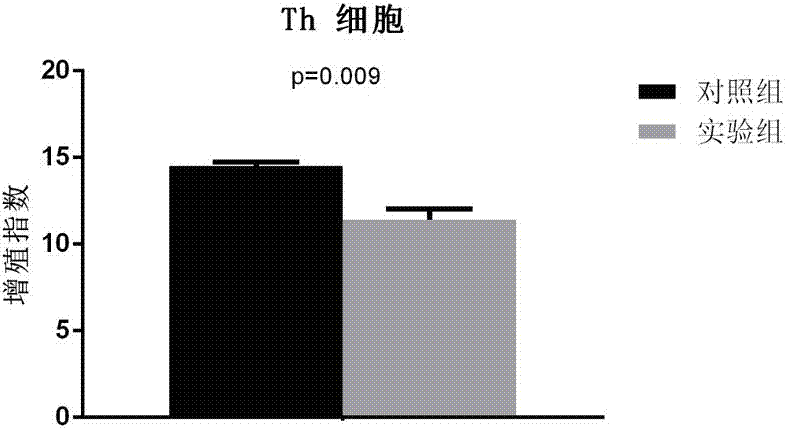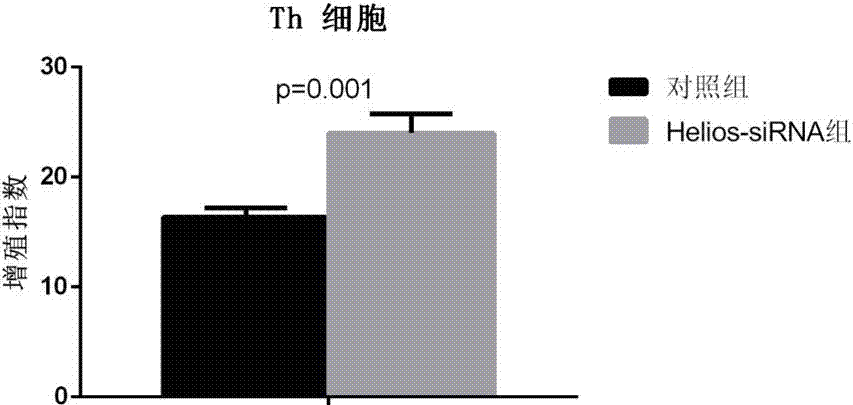Method for detecting immunosuppression function of human regulatory T cells
A technology of immunosuppression and detection method, applied in the direction of measuring devices, instruments, individual particle analysis, etc., can solve the problems affecting the maturation and function of Treg cells, insufficient to define the function and phenotype of Treg cells, etc.
- Summary
- Abstract
- Description
- Claims
- Application Information
AI Technical Summary
Problems solved by technology
Method used
Image
Examples
Embodiment 1
[0020] Treg cell detection
[0021] The materials used in this embodiment are mainly as follows:
[0022] (1) Specimen source: In this example, the peripheral blood approved and authorized by the family members of children with new-onset ALL and normal healthy children was used as the source of mononuclear cells. A total of 10 samples of ALL peripheral blood and 10 samples of normal control peripheral blood were collected. Add heparin for anticoagulation, 3-5ml per serving;
[0023] (2) Main reagents: mouse anti-human CD4-FITC and FoxP3-APC antibodies were purchased from ebiosicence Company in the United States, mouse anti-human CD25-PE-Cy5 and Helios-PE antibodies were purchased from Biolegend Company in the United States, and FoxP3 Fix / Perm buffer was purchased from ebioscience, red blood cell lysate was purchased from BD Biosciences, USA, the cell counter was Beck-mancoulter (U.S.), and the GuavaeasyCyte 6HT flow cytometer was produced by EMD Millipore, USA;
[0024] (3) ...
Embodiment 2
[0026] Isolation of mononuclear cells and sorting of Treg cells
[0027] (1) Specimen source: In this example, the peripheral blood approved and authorized by the family members of children with new-onset ALL and normal healthy children was used as the source of mononuclear cells. A total of 5 samples of ALL peripheral blood and 5 samples of normal control peripheral blood were collected. Add heparin for anticoagulation, 10ml each;
[0028] (2) Main reagents: lymphocyte separation fluid was purchased from Sigma, CD4 + CD25 + Treg cell separation kit, immunomagnetic bead sorter (autoMACS Pro Separator), MACS buffer, LD and MS MACS separation columns were purchased from Miltenyi Biotec, Germany;
[0029] (3) Separation of mononuclear cells: extract 10ml of heparin-anticoagulated peripheral blood, add an equal amount of PBS solution to the peripheral blood to dilute, take a 50ml centrifuge tube, carefully add 20ml of lymphocyte separation solution to each tube, and place 20ml o...
Embodiment 3
[0032] Detection of the immunosuppressive function of Treg cells
[0033] (1) Main reagents: Co-cultivation medium: Add 10% fetal bovine serum to 1640 medium, 100U / ml penicillin + chain
[0034] Mycin, 50μM / L 2-mercaptoethanol and 2mM / L L-glutamine, 200IU / mL rhIL-2. CD3 / CD28dynbeads were purchased from Invitrogen, USA, and CFSE was purchased from Dojin Chemical Research Institute, Japan;
[0035] (2) The CD4 sorted out in Example 2 + CD25 - Cells were washed and adjusted to 1×10 by adding PBS 7 Concentration, label 5μM CFSE according to CFSE instructions, incubate at 37°C for 15-30 minutes, wash twice with PBS, take 1×10 6 According to the ratio of cell number 2:1, Treg cells in experimental group 1, experimental group 2, and control group were added to 6-well plates for co-cultivation. The co-cultivation medium was used as the medium, and CD3 / CD28 dynbeads were cultured for 72 hours and cell proliferation was detected by flow cytometry, and the results were analyzed by ...
PUM
 Login to View More
Login to View More Abstract
Description
Claims
Application Information
 Login to View More
Login to View More - R&D
- Intellectual Property
- Life Sciences
- Materials
- Tech Scout
- Unparalleled Data Quality
- Higher Quality Content
- 60% Fewer Hallucinations
Browse by: Latest US Patents, China's latest patents, Technical Efficacy Thesaurus, Application Domain, Technology Topic, Popular Technical Reports.
© 2025 PatSnap. All rights reserved.Legal|Privacy policy|Modern Slavery Act Transparency Statement|Sitemap|About US| Contact US: help@patsnap.com



